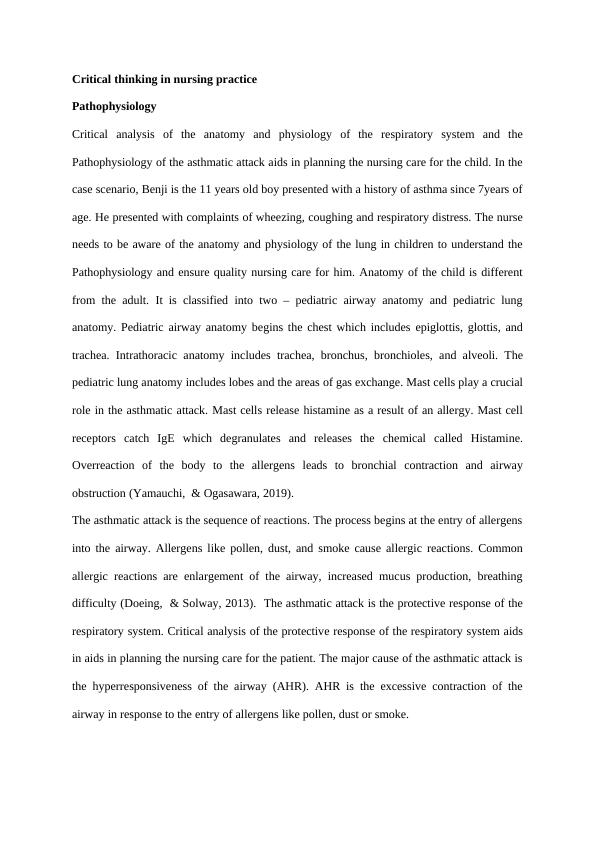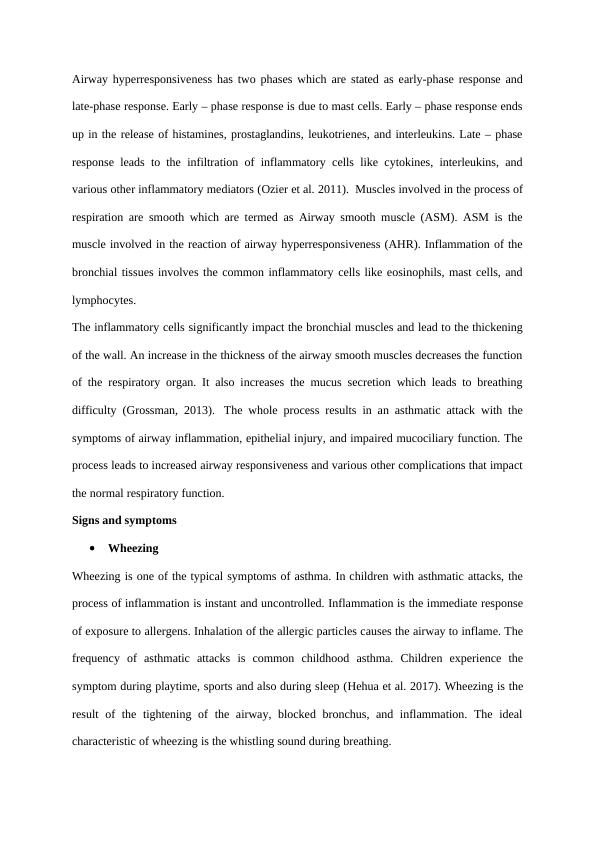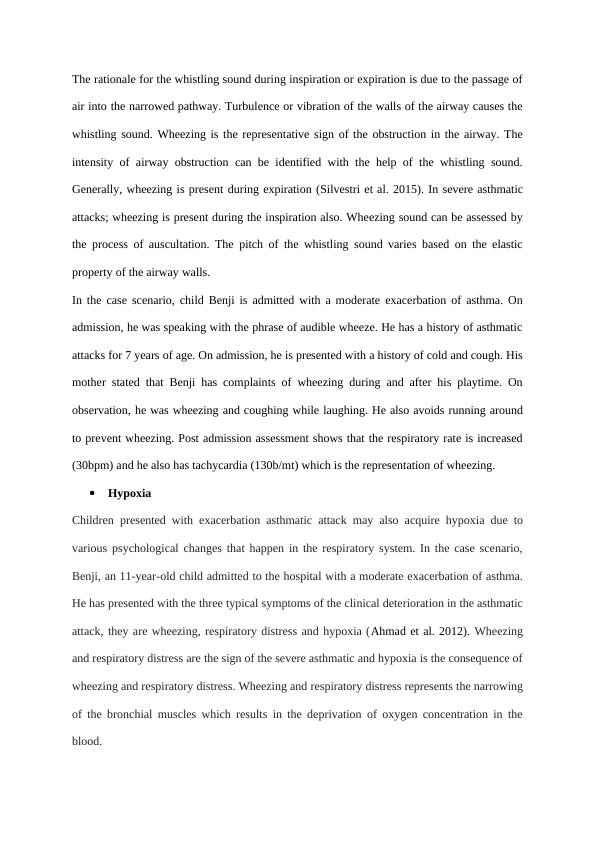The Critical thinking in nursing practice
Added on 2022-08-22
10 Pages3172 Words16 Views
Critical thinking in nursing practice
Pathophysiology
Critical analysis of the anatomy and physiology of the respiratory system and the
Pathophysiology of the asthmatic attack aids in planning the nursing care for the child. In the
case scenario, Benji is the 11 years old boy presented with a history of asthma since 7years of
age. He presented with complaints of wheezing, coughing and respiratory distress. The nurse
needs to be aware of the anatomy and physiology of the lung in children to understand the
Pathophysiology and ensure quality nursing care for him. Anatomy of the child is different
from the adult. It is classified into two – pediatric airway anatomy and pediatric lung
anatomy. Pediatric airway anatomy begins the chest which includes epiglottis, glottis, and
trachea. Intrathoracic anatomy includes trachea, bronchus, bronchioles, and alveoli. The
pediatric lung anatomy includes lobes and the areas of gas exchange. Mast cells play a crucial
role in the asthmatic attack. Mast cells release histamine as a result of an allergy. Mast cell
receptors catch IgE which degranulates and releases the chemical called Histamine.
Overreaction of the body to the allergens leads to bronchial contraction and airway
obstruction (Yamauchi, & Ogasawara, 2019).
The asthmatic attack is the sequence of reactions. The process begins at the entry of allergens
into the airway. Allergens like pollen, dust, and smoke cause allergic reactions. Common
allergic reactions are enlargement of the airway, increased mucus production, breathing
difficulty (Doeing, & Solway, 2013). The asthmatic attack is the protective response of the
respiratory system. Critical analysis of the protective response of the respiratory system aids
in aids in planning the nursing care for the patient. The major cause of the asthmatic attack is
the hyperresponsiveness of the airway (AHR). AHR is the excessive contraction of the
airway in response to the entry of allergens like pollen, dust or smoke.
Pathophysiology
Critical analysis of the anatomy and physiology of the respiratory system and the
Pathophysiology of the asthmatic attack aids in planning the nursing care for the child. In the
case scenario, Benji is the 11 years old boy presented with a history of asthma since 7years of
age. He presented with complaints of wheezing, coughing and respiratory distress. The nurse
needs to be aware of the anatomy and physiology of the lung in children to understand the
Pathophysiology and ensure quality nursing care for him. Anatomy of the child is different
from the adult. It is classified into two – pediatric airway anatomy and pediatric lung
anatomy. Pediatric airway anatomy begins the chest which includes epiglottis, glottis, and
trachea. Intrathoracic anatomy includes trachea, bronchus, bronchioles, and alveoli. The
pediatric lung anatomy includes lobes and the areas of gas exchange. Mast cells play a crucial
role in the asthmatic attack. Mast cells release histamine as a result of an allergy. Mast cell
receptors catch IgE which degranulates and releases the chemical called Histamine.
Overreaction of the body to the allergens leads to bronchial contraction and airway
obstruction (Yamauchi, & Ogasawara, 2019).
The asthmatic attack is the sequence of reactions. The process begins at the entry of allergens
into the airway. Allergens like pollen, dust, and smoke cause allergic reactions. Common
allergic reactions are enlargement of the airway, increased mucus production, breathing
difficulty (Doeing, & Solway, 2013). The asthmatic attack is the protective response of the
respiratory system. Critical analysis of the protective response of the respiratory system aids
in aids in planning the nursing care for the patient. The major cause of the asthmatic attack is
the hyperresponsiveness of the airway (AHR). AHR is the excessive contraction of the
airway in response to the entry of allergens like pollen, dust or smoke.

Airway hyperresponsiveness has two phases which are stated as early-phase response and
late-phase response. Early – phase response is due to mast cells. Early – phase response ends
up in the release of histamines, prostaglandins, leukotrienes, and interleukins. Late – phase
response leads to the infiltration of inflammatory cells like cytokines, interleukins, and
various other inflammatory mediators (Ozier et al. 2011). Muscles involved in the process of
respiration are smooth which are termed as Airway smooth muscle (ASM). ASM is the
muscle involved in the reaction of airway hyperresponsiveness (AHR). Inflammation of the
bronchial tissues involves the common inflammatory cells like eosinophils, mast cells, and
lymphocytes.
The inflammatory cells significantly impact the bronchial muscles and lead to the thickening
of the wall. An increase in the thickness of the airway smooth muscles decreases the function
of the respiratory organ. It also increases the mucus secretion which leads to breathing
difficulty (Grossman, 2013). The whole process results in an asthmatic attack with the
symptoms of airway inflammation, epithelial injury, and impaired mucociliary function. The
process leads to increased airway responsiveness and various other complications that impact
the normal respiratory function.
Signs and symptoms
Wheezing
Wheezing is one of the typical symptoms of asthma. In children with asthmatic attacks, the
process of inflammation is instant and uncontrolled. Inflammation is the immediate response
of exposure to allergens. Inhalation of the allergic particles causes the airway to inflame. The
frequency of asthmatic attacks is common childhood asthma. Children experience the
symptom during playtime, sports and also during sleep (Hehua et al. 2017). Wheezing is the
result of the tightening of the airway, blocked bronchus, and inflammation. The ideal
characteristic of wheezing is the whistling sound during breathing.
late-phase response. Early – phase response is due to mast cells. Early – phase response ends
up in the release of histamines, prostaglandins, leukotrienes, and interleukins. Late – phase
response leads to the infiltration of inflammatory cells like cytokines, interleukins, and
various other inflammatory mediators (Ozier et al. 2011). Muscles involved in the process of
respiration are smooth which are termed as Airway smooth muscle (ASM). ASM is the
muscle involved in the reaction of airway hyperresponsiveness (AHR). Inflammation of the
bronchial tissues involves the common inflammatory cells like eosinophils, mast cells, and
lymphocytes.
The inflammatory cells significantly impact the bronchial muscles and lead to the thickening
of the wall. An increase in the thickness of the airway smooth muscles decreases the function
of the respiratory organ. It also increases the mucus secretion which leads to breathing
difficulty (Grossman, 2013). The whole process results in an asthmatic attack with the
symptoms of airway inflammation, epithelial injury, and impaired mucociliary function. The
process leads to increased airway responsiveness and various other complications that impact
the normal respiratory function.
Signs and symptoms
Wheezing
Wheezing is one of the typical symptoms of asthma. In children with asthmatic attacks, the
process of inflammation is instant and uncontrolled. Inflammation is the immediate response
of exposure to allergens. Inhalation of the allergic particles causes the airway to inflame. The
frequency of asthmatic attacks is common childhood asthma. Children experience the
symptom during playtime, sports and also during sleep (Hehua et al. 2017). Wheezing is the
result of the tightening of the airway, blocked bronchus, and inflammation. The ideal
characteristic of wheezing is the whistling sound during breathing.

The rationale for the whistling sound during inspiration or expiration is due to the passage of
air into the narrowed pathway. Turbulence or vibration of the walls of the airway causes the
whistling sound. Wheezing is the representative sign of the obstruction in the airway. The
intensity of airway obstruction can be identified with the help of the whistling sound.
Generally, wheezing is present during expiration (Silvestri et al. 2015). In severe asthmatic
attacks; wheezing is present during the inspiration also. Wheezing sound can be assessed by
the process of auscultation. The pitch of the whistling sound varies based on the elastic
property of the airway walls.
In the case scenario, child Benji is admitted with a moderate exacerbation of asthma. On
admission, he was speaking with the phrase of audible wheeze. He has a history of asthmatic
attacks for 7 years of age. On admission, he is presented with a history of cold and cough. His
mother stated that Benji has complaints of wheezing during and after his playtime. On
observation, he was wheezing and coughing while laughing. He also avoids running around
to prevent wheezing. Post admission assessment shows that the respiratory rate is increased
(30bpm) and he also has tachycardia (130b/mt) which is the representation of wheezing.
Hypoxia
Children presented with exacerbation asthmatic attack may also acquire hypoxia due to
various psychological changes that happen in the respiratory system. In the case scenario,
Benji, an 11-year-old child admitted to the hospital with a moderate exacerbation of asthma.
He has presented with the three typical symptoms of the clinical deterioration in the asthmatic
attack, they are wheezing, respiratory distress and hypoxia (Ahmad et al. 2012). Wheezing
and respiratory distress are the sign of the severe asthmatic and hypoxia is the consequence of
wheezing and respiratory distress. Wheezing and respiratory distress represents the narrowing
of the bronchial muscles which results in the deprivation of oxygen concentration in the
blood.
air into the narrowed pathway. Turbulence or vibration of the walls of the airway causes the
whistling sound. Wheezing is the representative sign of the obstruction in the airway. The
intensity of airway obstruction can be identified with the help of the whistling sound.
Generally, wheezing is present during expiration (Silvestri et al. 2015). In severe asthmatic
attacks; wheezing is present during the inspiration also. Wheezing sound can be assessed by
the process of auscultation. The pitch of the whistling sound varies based on the elastic
property of the airway walls.
In the case scenario, child Benji is admitted with a moderate exacerbation of asthma. On
admission, he was speaking with the phrase of audible wheeze. He has a history of asthmatic
attacks for 7 years of age. On admission, he is presented with a history of cold and cough. His
mother stated that Benji has complaints of wheezing during and after his playtime. On
observation, he was wheezing and coughing while laughing. He also avoids running around
to prevent wheezing. Post admission assessment shows that the respiratory rate is increased
(30bpm) and he also has tachycardia (130b/mt) which is the representation of wheezing.
Hypoxia
Children presented with exacerbation asthmatic attack may also acquire hypoxia due to
various psychological changes that happen in the respiratory system. In the case scenario,
Benji, an 11-year-old child admitted to the hospital with a moderate exacerbation of asthma.
He has presented with the three typical symptoms of the clinical deterioration in the asthmatic
attack, they are wheezing, respiratory distress and hypoxia (Ahmad et al. 2012). Wheezing
and respiratory distress are the sign of the severe asthmatic and hypoxia is the consequence of
wheezing and respiratory distress. Wheezing and respiratory distress represents the narrowing
of the bronchial muscles which results in the deprivation of oxygen concentration in the
blood.

End of preview
Want to access all the pages? Upload your documents or become a member.
Related Documents
Acute Life-Threatening Conditions: Pathogenesis, Clinical Manifestations, and Treatmentlg...
|8
|2430
|53
Priority Problems in Asthma: Ineffective Airway Clearance and Impaired Gaseous Exchangelg...
|13
|3513
|23
Pathophysiology of Asthma and Clinical Manifestations: A Case Studylg...
|8
|1938
|93
Body Integrity Assignment PDFlg...
|5
|1450
|42
Nursing Priorities-Status Asthmaticuslg...
|23
|3456
|77
Case Study Analysis of Asthmalg...
|11
|2258
|16
